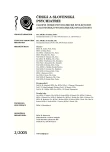Safety and Tolerability of Second and Third Generation Antipsychotics
Snášenlivost a bezpečnost antipsychotik druhé a třetí generace
Autoři se nejprve zabývají vývojem nových antipsychotik. V popředí zájmu jsou nyní nová antipsychotika, také nazývaná atypická nebo antipsychotika druhé a třetí generace. I když jsou spojena s menším výskytem vedlejších extrapyramidových účinků, mohou způsobit jiné vedlejší účinky. Tyto mohou být problematické, protože schizofrenní nemocní jsou zatíženi vyšší morbiditou a mortalitou na kardiovaskulární onemocnění bez ohledu na léčbu. K těmto vedlejším účinkům patří přírůstek hmotnosti, narušení glukózového metabolismu, dyslipidémie a prodloužení QT intervalu. Jsou shrnuty dosavadní znalosti o této problematice. Na závěr jsou uvedeny vlastní údaje týkající se výskytu prodloužení QT u neselektované populace nemocných hospitalizovaných na Psychiatrické klinice FN v Brně-Bohunicích. Zjištěný výskyt (4,1 % léčených) je menší než v dostupné literatuře. Je to zřejmě způsobeno změnou preskripce ve smyslu preference antipsychotik druhé generace, užíváním obecně nižších dávek a informovanosti lékařů o tomto fenoménu.
Klíčová slova:
antipsychotika druhé a třetí generace, vedlejší extrapyramidové účinky, morbidita, mortalita, prodloužení QT intervalu.
Authors:
E. Češková; T. Novotný 1; A. Floriánová 2; V. Pálenský
Authors‘ workplace:
Kardiologická klinika LF MU a FN, Brno
přednosta prof. MUDr. J. Špinar, CSc.
; Psychiatrická klinika LF MU a FN, Brno
přednosta prof. MUDr. E. Češková, CSc.
Published in:
Čes. a slov. Psychiat., 101, 2005, No. 2, pp. 92-97.
Category:
Comprehensive Reports
Overview
At first the authors deal with new antipsychotics. In the centre of interest there are new antipsychotics, often referred to as atypical or antipsychotics of the second or third generation. The atypical antipsychotics carry less risk or EPS, however, they can cause other side effects. These can be a problem, because schizophrenic patients have higher rate of morbidity and mortality from cardiovascular disease independent from treatment. These side effects include weight gain, diabetes, hyperlipidemia and QT prolongation. The published data concerning this topic are summarized. Finally the data concerning the QT prolongation in unselected population of hospitalised psychiatric patients at Brno psychiatric department are presented. The occurrence (4.1 % of patients) of abnormal QTc was lower than in the so-far available literature. This could be connected with the change of spectrum of antipsychotics used, the general trend to use lower doses of antipsychotics and prescribers increasing awareness about this phenomenon.
Key words:
second and third generation antipsychotics, extrapyramidal side effects, morbidity, mortality, prolongation of QT interval.
Labels
Addictology Paediatric psychiatry PsychiatryArticle was published in
Czech and Slovak Psychiatry

2005 Issue 2
- Hope Awakens with Early Diagnosis of Parkinson's Disease Based on Skin Odor
- Memantine in Dementia Therapy – Current Findings and Possible Future Applications
- Memantine Eases Daily Life for Patients and Caregivers
- Deep stimulation of the globus pallidus improved clinical symptoms in a patient with refractory parkinsonism and genetic mutation
Most read in this issue
- Safety and Tolerability of Second and Third Generation Antipsychotics
- Prediction of Efficacy of Inpatient Treatment in Metamphetamine Dependence
- Psychosocial Stressors in Young Families from Brno and Znojmo Part II
- Pesso Boyden Psychomotor Therapy in the Treatment of Traumatized in Patients, Survivors of Second World War in the Former Dutch East Indies
